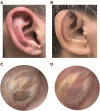Developing a novel meatal areolar tissue autograft for minimally invasive tympanoplasty
- PMID: 32649410
- PMCID: PMC7526586
- DOI: 10.1097/JCMA.0000000000000392
Developing a novel meatal areolar tissue autograft for minimally invasive tympanoplasty
Abstract
Background: We developed an easy and minimally invasive method of transmeatal tympanoplasty using meatal areolar tissue (MAT) grafts to achieve less postoperative morbidity or surgical scarring. We compared the functional and anatomical results of the developed method with conventional endaural tympanoplasty with a temporalis fascia (TF) graft.
Methods: In this retrospective cohort study, 58 patients (59 ears) with simple chronic otitis media who underwent type I tympanoplasty between January 2016 and August 2018 were included. All surgeries were performed in a tertiary referral hospital and by the same senior surgeon. The tympanic membrane (TM) was repaired with either a TF or an MAT graft.
Results: Healing of the perforated TM and improvement in a hearing test by air-bone gap (ABG) closure were identified. Postoperative wound conditions were also evaluated. Twenty-eight ears were grafted with MAT, and 31 ears were grafted with TF. Graft success was observed in 26 patients (92.9%) in the MAT group and 28 patients (90.3%) in the TF group. Both groups showed functional improvement compared with the preoperative measurements. The postoperative pure tone audiogram (p = 0.737), ABG closure (p = 0.547), and graft success rate (p = 0.726) were not significantly different between the two groups. Neither wound dehiscence nor keloid formation was observed in our patients.
Conclusion: Both MAT and TF grafts revealed satisfactory surgical and functional results. Compared with the conventional endaural approach with TF grafts, the new transmeatal approach method with an MAT graft causes relatively minimal trauma and results in better wound cosmetics. This method represents an easy, minimally invasive surgery and shows comparatively good results.
Conflict of interest statement
Conflicts of interest: The authors declare that they have no conflicts of interest related to the subject matter or materials discussed in this article.
Figures



References
-
- Pinar E, Sadullahoglu K, Calli C, Oncel S. Evaluation of prognostic factors and middle ear risk index in tympanoplasty. Otolaryngol Head Neck Surg. 2008;139:386–90. - PubMed
-
- Merchant SN, Ravicz ME, Puria S, Voss SE, Whittemore KR, Jr, Peake WT, et al. Analysis of middle ear mechanics and application to diseased and reconstructed ears. Am J Otol. 1997;18:139–54. - PubMed
-
- Perkins R. Human homograft otologic tissue transplantation buffered formaldehyde preparation. Trans Am Acad Ophthalmol Otolaryngol. 1970;74:278–82. - PubMed
-
- Awad OG, Hamid KA. Endoscopic type 1 tympanoplasty in pediatric patients using tragal cartilage. JAMA Otolaryngol Head Neck Surg. 2015;141:532–8. - PubMed
-
- Ayache S, Beltran M, Guevara N. Endoscopic classification of the external auditory canal for transcanal endoscopic ear surgery. Eur Ann Otorhinolaryngol Head Neck Dis. 2019;136:247–50. - PubMed
MeSH terms
LinkOut - more resources
Full Text Sources
Miscellaneous

